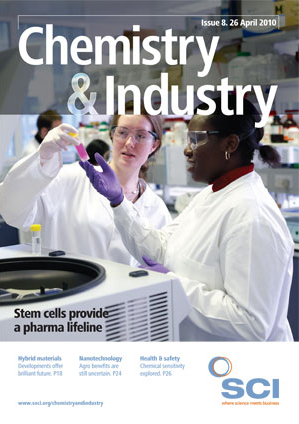New and improved materials – often combining more than one compound – will be vital for applications from aerospace to lighting and civil engineering. Cath O’Driscoll reports from an EU Suschem workshop on hybrid materials in Luxembourg
Try Googling the word ‘hybrid’ and the result is ‘something suspicious, a chimera or crossover of topics,’ said Gernod Klotz, executive director responsible for research & innovation at CEFIC and member of the board of SusChem, the EU technology platform for sustainable chemistry. For most public and private actors, ‘this idea is not well liked as it does not fit the conventional silos that we are used to working in,’ he added. Hybrid materials, however, have an altogether more practical role. They combine the properties of two or more different materials to create new ones with added functionalities that make them useful both in existing products as well as for new and previously undreamt of applications.
Invisible revolution
Indeed, ‘70% of all technical innovations are directly related to new materials,’ according to a study mentioned by Renzo Tomellini, head of the European Commission’s added value materials unit. Tomellini labels new materials as ‘Knowledgemediaries’ that transport intelligence into products; they represent an ‘invisible revolution’ leading ultimately both to economic growth and the creation of more jobs.
Klotz and Tomellini were speaking at the start of a two-day workshop in Luxembourg in March aimed at bringing together material manufacturers, academics, end-users and other stakeholders to discuss the future material needs of the EU’s automotive, solar energy, solid state lighting, civil engineering and aviation/aerospace sectors. The outcome will be presented to the European Commission and serve as input to the 8th Research Framework Programme which starts in 2013.
While hybrid materials are already making a major impact on modern lifestyles – from composites in cars and planes to inorganic-organic mixtures such as the soot-rubber blends in car tires – they clearly have much greater potential for growth. New nanotechnologies, for example, now allow even more intimate connections between the component compounds, together with the generation of completely unexpected properties often unrelated to the initial starting chemistries. And advanced tools for modelling and designing hybrids mean that they can be created with more control and accuracy than in the past: what Tomellini calls a ‘new atomic precision industry’.
But with limited funding available to design and develop new hybrid materials, the main issue for delegates in Luxembourg to consider was how best to prioritise research programmes to derive the maximum value from them.
In the aviation sector, a key challenge for the future will be to further reduce aircraft weight, so reducing fuel consumption, while at the same time improving recyclability, says Airbus’ head of structure policy & development, Bruno Beral. The ideal aircraft would have wings with variable geometry to reduce friction, use non-fossil fuels that produce clean combustion products, and be easy to fly and maintain as well as simple and comfortable for passengers, he explained. While modern aircraft increasingly use higher amounts of composites in their design – currently around 50% metal: 50% composites – Beral pointed out that further weight losses will demand greater multi-functionality from materials that combine self-healing, de-icing and electrical conductivity properties etc all at the same time.
By 2093, the vision is for ‘a morphing structure to improve flight efficiency,’ Beral continued: in other words, for planes that are capable of changing their shape according to the prevailing flight conditions, so reducing drag and massively improving fuel efficiency. Shape memory alloys that remember and return to their original form after being acted on by an external force – such as temperature – are a possible candidate, but still need a lot of work to make them more acceptable by industry.
To mature and validate a new aircraft material typically takes around 10 years and costs millions of Euros, Beral said, adding that the approach is generally to try to share these costs among the aerospace company, material suppliers and customers. In terms of ‘recyclability’, thermoplastic composites are already better than the current thermosets – and also meet all of the toxicity requirements demanded by REACH legislation, he pointed out. But while thermoplastics materials are ‘very good candidates for the future, the main drawback is price,’ he said.
Aerodynamics of the car
Vehicle weight reduction is a continuing concern too in the automotive sector. Despite progress to substitute metals by lightweight plastics, in fact ‘not a single car has reduced weight in the past 20 years’, said Ton Peijs, professor of materials at Queen Mary University of London, UK, largely because of the growing demands for more electronic and other gadgetry. Around 18 polymers are currently involved in the construction of a typical car – mainly polypropylene, polyurethane and polyamide along with various blends; however, because of the recent EU End of Life Vehicles directive there has been a shift away from hybrid materials as they are harder to recycle, Peijs added.
However, lightweight materials – hybrid or other types – will certainly have a role in helping to meet new legislation to reduce vehicle CO2 emissions, commented Jean Claude Steinmetz, automotive market director at Rhodia. By 2012 the EC requires that all vehicles must reduce CO2 emissions down to 130g/km; and to 95g/km by 2020, and ‘all manufacturers still have some work to do to comply with the 2012 target,’ Steinmetz said. About 70% of CO2 emissions occur as a result of overcoming rolling resistance and inertia during city driving, Steinmetz explained – making weight reduction and green tyres priority areas to reduce petrol consumption.
‘On the motorway the main contributor to CO2 is the aerodynamics of the car,’ he continued, ‘therefore facilities to shape aerodynamic stylings are essential and can be achieved with lightweight and high performance polymers’.
Further into the future, workshop delegates speculated that next generation cars will probably be driven more like computer games, perhaps using touch sensitive keypads reliant on information relayed by satellites and sensors – with all of the new material demands these developments entail. They are also likely to feature more glazing, giving occupants greater all-round visibility.
In the solar sector, meanwhile, hybrid materials have long promised the possibility of a ‘supermaterial’ that combines the best features of both organic and inorganic materials, continued Markus Scharber, director of innovation and IP at Konarka Technologies. Inorganic materials are good charge carriers but have poor optical properties – just the opposite of organic materials, so combining the two should theoretically produce hybrids with good electrical and optical characteristics, ideal for PV modules. However, ‘breakthrough’ hybrid solar cells produced earlier this year still have some way to go to be competitive, Scharber pointed out, with device efficiencies of 1.5% – ten times less than silicon and fi ve or six times lower than for organic or dyesensitive/ Gratzel cells. As for all sectors of material research, unfortunately ‘forming a hybrid often does not lead to a combination of desired properties,’ he noted.
Further into the future, Scharber continued, third generation PV technology will ultimately depend on the development of new materials that can be printed on modern printing machines – leading to big energy and cost savings for device manufacturers.
And better materials will also be important for solid state lighting improvements, says Volker van Elsbergen, project manager OLED lighting at Philips Research. Organic light emitting diodes (OLEDs) now just starting to appear on the marketplace could potentially be the next generation of lighting after conventional low energy light bulbs, van Elsbergen explained, pointing out that OLEDS offer a flat light source as opposed to the point sources with which consumers are now more familiar. They are also very efficient, can be made in many different colours and produce a good quality light effect favoured especially by architects and designers.
The Philips Lumiblade Mirrorwall, for example, was recently exhibited at the International Design Museum in Munich, Germany. It overs a wall with hundreds of small OLEDs to create an interactive mirror. Walking or standing in front of the wall switches off any OLEDS in front of the viewer, creating the effects shown.
However, one of the challenges currently hampering OLED development, Elsbergen explained, is the so-called ‘light out-coupling problem’, by which only 20-30% of the light from the OLED escapes from the surrounding glass or organic layers. What is needed are new substrate materials with a high refractive index that scatter light, are conductive and flexible, van Elsbergen said. While OLEDs already have some decorative applications, he added that ‘to go to general lighting [applications] we will need to improve on luminous efficacy, lifetime, and costs of OLEDS’.

New nanofoams and concrete additives that promise to slash greenhouse gas are in the development pipeline with some products now starting to make their way onto the marketplace, he pointed out.
Future homes will also need to become more intelligent, Carosio continued, incorporating sensors, smart textiles and other multifunctional materials that are more responsive to their occupants’ needs. ‘Materials will need to be stronger, lighter, more durable to introduce robustness and be adaptive to the environment,’ he said.
These introductory overviews, however, were just the scene-setting discussions for the subsequent workshops, during which participants carried out an analysis and outlined a number of research priorities – many of them with possible applications across the various sectors.
The key challenge now will be to take them forward into concrete actions, Klotz said. With the timeline for new material development and market typically of the order of 10 years or so, it would appear that there is little time to waste. Finally, as Jacques Joosten, managing director of the Dutch Polymer Institute, pointed out: ‘Especially the involvement of end users of hybrid materials could have a great influence on the future developments in the various sectors.’
This article was based on a workshop organised by the EU technology platform for sustainable chemistry (SusChem), in cooperation with the Dutch Polymer Institute (DPI) and supported by the European Commission (DG Research).





